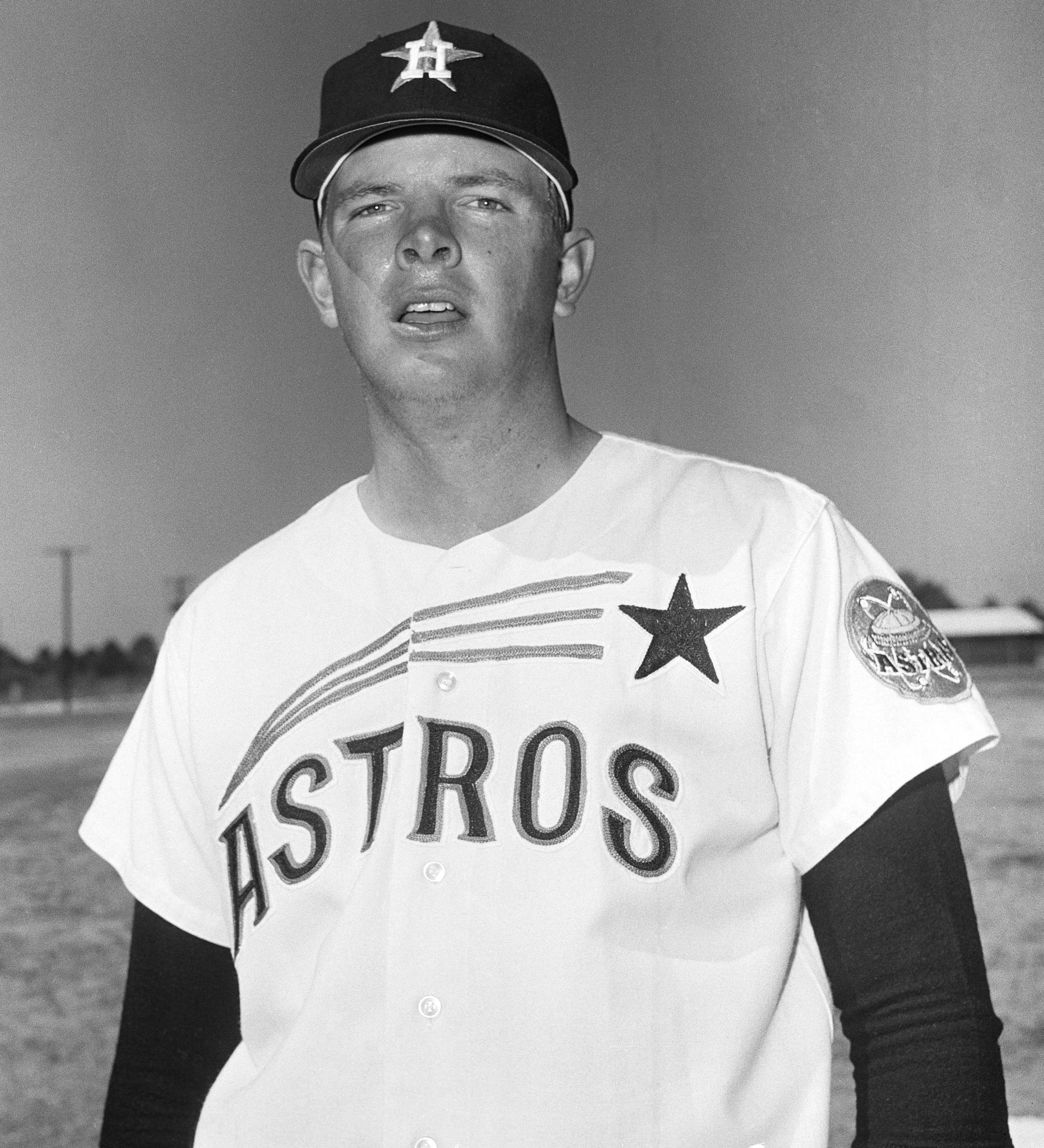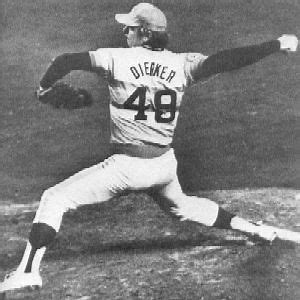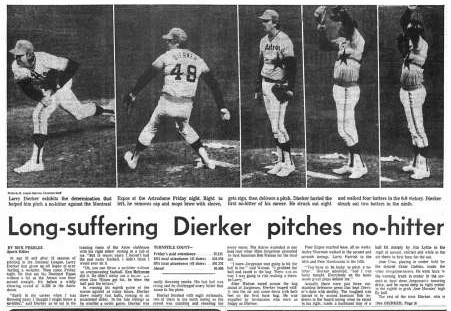July 9, 1976
Larry Dierker made his major-league debut on his 18th birthday in September 1964  as a hard-throwing righthanded pitcher for the Houston Colt .45s. Twelve years later – July 9, 1976 – he threw his only MLB no-hitter against the Montreal Expos.
as a hard-throwing righthanded pitcher for the Houston Colt .45s. Twelve years later – July 9, 1976 – he threw his only MLB no-hitter against the Montreal Expos.
By then, Dierker was a much-different pitcher than the young kid who struck out Willie Mays in the first inning of that first game. Shoulder and elbow injuries left him in near-constant pain when he pitched, and the blazing fastball and hard slider were pretty much consigned to memory. And when he did pitch, he threw nearly sidearm instead of overhand, to reduce the pain and still be effective.
“I didn’t think I would ever do it,” he said after the game.
“It was like a gift from God.” — Larry Dierker, about his late-career no-hitter
Near-misses earlier in his career made him think his chances to pitch a no-hitter may have come and gone.
“I had one in New York that was a perfect game into the ninth inning,” he remembered, “but I gave up a couple of hits and lost the game 1-0. I had another one in the ninth in Atlanta, and Felix Millan got an infield hit with two outs [in 1969]. I was only 24 years old and I figured I would have more chances to pitch a no-hitter. But by the time it happened in 1976, I certainly wasn’t in the same frame of mind.”
“It meant more to me, because it never occurred to me that I would pitch a no-hitter at that juncture, because of the shape my arm was in,” he said.
“I didn’t have the kind of overpowering stuff that I could have occasionally when I  was younger, and I didn’t think it would be possible, so I really felt blessed to have that happen — because after coming close a couple of times, then being all worn-out when it happened, it was like a gift from God.
was younger, and I didn’t think it would be possible, so I really felt blessed to have that happen — because after coming close a couple of times, then being all worn-out when it happened, it was like a gift from God.
“When I took the mound that day, I was determined to mix my pitches and forget about trying to throw the ball by the hitters,” he said in This Ain’t Brain Surgery. “I felt I had been overthrowing, trying to prove that I could still throw hard. I had made too many mistakes going for velocity over location.”
The plan worked well early in the game, but as the innings went by, Dierker noticed he had an especially good fastball that day: it was sailing, and he could throw it past the hitters.
Enter Plan B.
“I began to think about the no-hitter in the seventh inning,” he said. “I had trouble in the fifth with my control (for the game, he walked four and struck out eight) but when I came out in the sixth, suddenly I had my stuff again.
“For the rest of the game, all I did was rush it in there.”
— Dierker, on pitching the late innings with only his fastball
The memory of those near-misses led Dierker to use his fastball exclusively in the late innings. He had lost the no-hitter against the Braves on a slider.
“I was determined to get outs on strikeouts, popups, or fly balls,” he recalled.
In the ninth inning, he struck out Pepe Mangual, then fell behind Jim Lyttle 2-0 before he struck Lyttle out on three consecutive fastballs.
Up came Mike Jorgensen, a hitter who had given Dierker trouble in previous games.
“I was determined to go with my bread-and-butter, which was the fastball,” Dierker said.
The final out “came more on luck than design,” Dierker said. The first-pitch fastball rode up-and-in on Jorgensen, and he got on top of the ball, hitting a grounder to first-baseman Bob Watson, who took the ball to the bag himself.
“I knew Jorgensen was going to hit the ball to me,” Watson said. “There was no way I was going to risk making a throw to Larry.”
Dierker leaped in the air as the final out was made, and he landed on first base.
“There’s a lot of luck in it,” Dierker said later. “[Roger] Clemens and [Steve] Carlton never did it. They faced a million batters – Cy Young Awards, and all that. Ken Holtzman threw a no-hitter without a single strikeout. What are the odds of 27 balls being hit, and none finding a hole?”
“In my game, there were a couple of good plays, but nothing extraordinary,” he remembered.
The no-hitter got Dierker a $2,500 raise. Not bad for a game where the pregame plan was scrapped early on.
“A reporter asked me after the game when I knew I had a no-hitter, and I said, ‘after the first inning,’” he said. “The way I have been pitching, I was trying to remember the last time I got through the first inning without giving up a hit. I went back in and thought, ‘this is pretty cool. I didn’t have trouble in the first inning today.’”
“I didn’t throw an off-speed pitch after the fourth inning, which is exactly the opposite of the strategy I was determined to employ at the beginning of the game,” he wrote in This Ain’t Brain Surgery.
